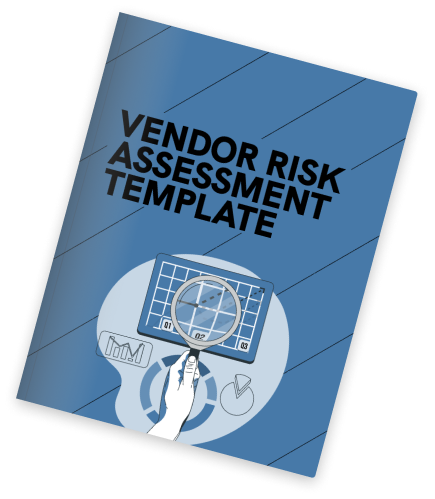
In today's interconnected world, companies of all sizes make outsourcing a key component of their business model. Outsourcing work to third-party contractors helps businesses in all industries be responsive and agile in a disruptive environment and may even provide them with a competitive advantage.
When you work with third parties, they also pose additional risks up and down the supply chain. Risk significance depends on various factors, including the vendor's importance to your business, the ability to replace them, and the business implications of a non-compliant vendor.
That's why third-party risk assessments are vital for any business, and they must be performed not just at the time of onboarding but continually on an ongoing cadence.
A third-party risk assessment involves analyzing vendor risk posed by a company's third-party relationships along the entire supply chain, including suppliers, vendors, and service providers. It's a vital component of the broader set of third-party risk management practices.
The primary purpose of a third-party risk assessment is to identify and evaluate the potential risks that each of the third-party relationships poses to a business. This assessment serves as an internal function to mitigate the risks as much as possible and may be conducted in-house or by an independent safety or cybersecurity professional. It's essential to consider different types of risks, including security, privacy, business continuity, reputation, etc.
You can't completely eliminate all vendor risk, but you can manage it by assessing all the risks that come with each vendor as part of your due diligence process. A vendor risk assessment is an audit of the vendor's processes, policies, and financial health. It helps understand how much risk you'll take on when working with a specific vendor.
Usually, vendor risk assessments include the following steps:
First, you should make a list of your vendors and classify them. You should identify the most important to your success, present the most risk, and should be subject to a supplier risk assessment. This is a critical step because the average midsize-to-large company deals with hundreds, or even thousands, of vendors. At best, you'll be able to assess a small percentage of total third parties working with you, so you should make informed decisions about which vendors to work with.
Then you need to build your assessment – it's usually in a questionnaire format. You can create it in-house, use a resource you find online, or take advantage of vendor risk management software. You should use this questionnaire to find out more about your vendors' policies, processes, and procedures so you can determine their additional risks. Don't be afraid to ask for proof of the company's standards in areas you may have concerns.
But it's also important to keep things simple and concise. Don't include too many items on the questionnaire, and don't ask freeform questions because you may end up with incomplete and inaccurate responses.
Your vendors should complete the assessment, and in some situations, you may need to help them. They may need multiple employees to answer questions, and documentation might be required as well.
After each vendor completes the assessment, you'll need to examine their answers and analyze the results. It's important to assign each vendor a risk rating based on the level of risk and the number of potential risks they pose to your business.
You need to evaluate the risks posed by each vendor and decide what risk management strategy will be appropriate to mitigate the risk and take action based on the results. Often, you'll need to request the supplier to address any significant concerns. In some cases, you may want to ask for an on-site audit that will allow you to understand better how a vendor operates and do a more in-depth evaluation.
And in rare cases, you may need to remove the vendor from your list altogether. This can happen in high-risk situations where practically nothing can be done to mitigate risks.
You may also decide to request additional assessments on a more regular basis – it depends on the supplier and their risk profile. Such assessments can be performed several times a year to once in a couple of years.
A solid risk assessment strategy will help you create and maintain relationships with suppliers and ensure your business has the greatest chance of success in the long term.
If you're new to the assessment process, take a look at the best practices for successful supplier risk assessment:
Third-party risk assessments are a sound business practice. Risk assessment questionnaires that include the right questions can help identify potential weaknesses among vendors and partners resulting in a breach. This way, your company can avoid some costly and unanticipated surprises down the road because you'll be aware of the possible risks upfront.
To help you get started, we have created a vendor evaluation template, that you can download at no cost, which contains a list of questions you should consider asking your current or potential vendors.

If you are new to risk assessments, you can download a basic vendor risk assessment template to better understand which questions you should consider including in your vendor risk assessment questionnaire.
You should remember that creating a third-party risk assessment questionnaire is not enough. It's a critical step, but it's not the only step in the assessment.
Conducting vendor risk assessments can be a long and tedious process. But tools like START can greatly simplify the tasks of assessing and managing third-party risks. With START, you'll be able to:
1. Create controls and questionnaires and customize them to ensure that you ask your vendors relevant questions, ultimately saving them time and money.

2. Keep the single source of truth throughout the process in one convenient window

3. Monitor the process and send automated reminders to ensure your vendors complete assessments on time.

Vendor risk assessment is a critical part of a vendor management program for any company. Identifying risks during a third-party risk assessment is an important step, but a single evaluation is not enough for an effective overall management plan.
Risk assessments are integral parts of comprehensive third-party risk management (TPRM) programs. They help you determine specific areas of risk you may want to monitor more thoroughly. And since vendors evolve and risks change over time, you should reassess your critical and high-risk vendors at least annually. Ongoing monitoring and due diligence are necessary to ensure that your business relationships are safe and beneficial for both parties.